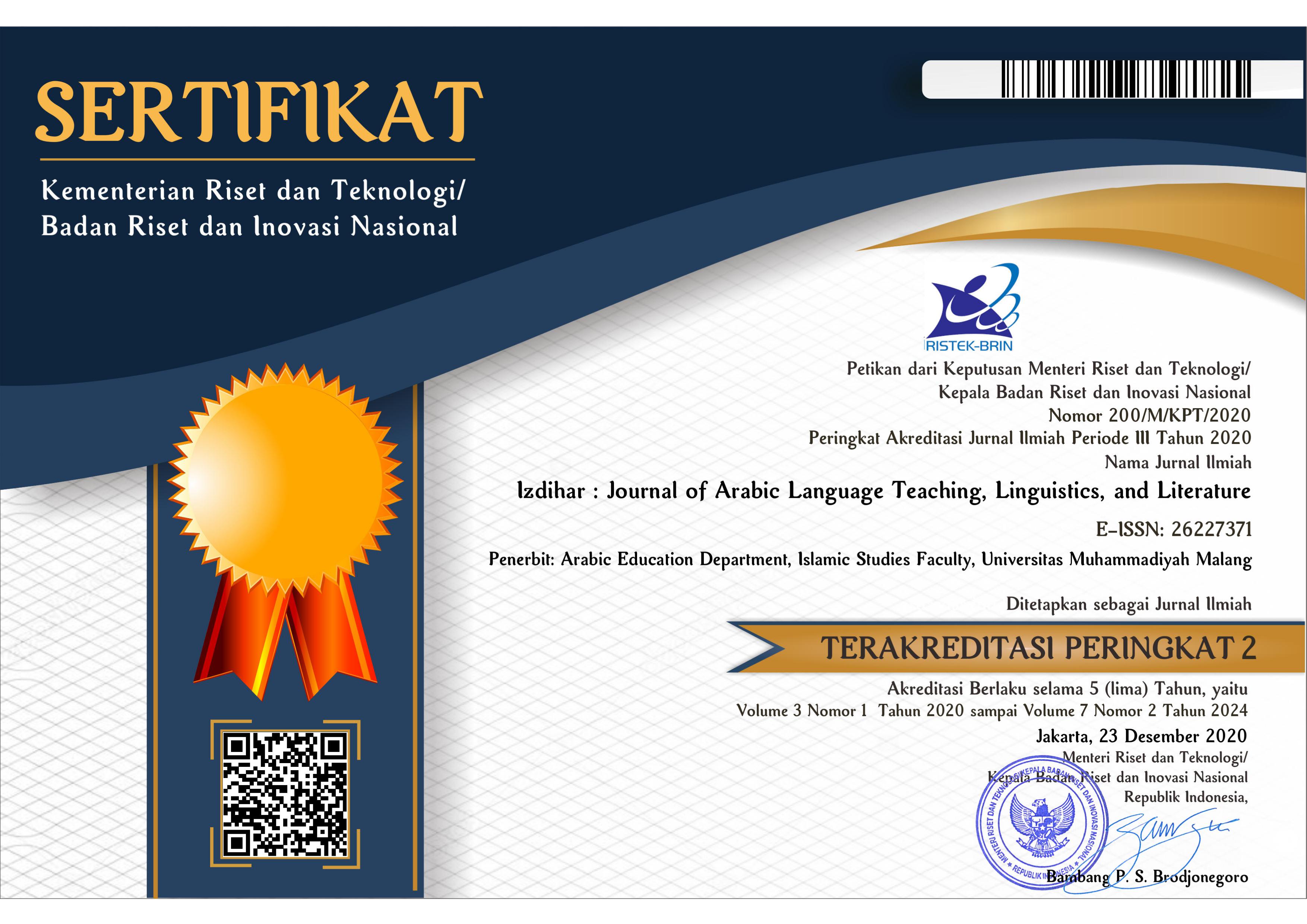Developing Hiwaruna as Arabic Conversation Book for Speaking Skills in Islamic Boarding School
DOI:
https://doi.org/10.22219/jiz.v5i2.22935Keywords:
Arabic Language, Conversation Book, Islamic Boarding SchoolsAbstract
This study aims to develop an Arabic conversation textbook at the Islamic Boarding School Themes For Students of Al Kamal Islamic Boarding School Blitar, East Java. The development is a solution of unavailability textbook to speak daily Arabic in Islamic boarding schools. This study uses the ADDIE development model. The subjects of the product trial were class 1D students at the Al Kamal Islamic Boarding School. The data collection techniques used were observation, interviews, and questionnaires. The result of this research is a daily Arabic conversation book entitled "Hiwaruna" for learning speaking skills at the Al Kamal Islamic Boarding School Blitar. This book contains themes that are closely related to daily life in Islamic boarding schools. The results of product validation from material and media experts obtained an average value of 82.50% with the information that it is very suitable for use in Arabic speaking learning at Islamic boarding schools.
Downloads
References
AbuSyairi, K. (2013). Pengembangan bahan ajar bahasa Arab. Dinamika Ilmu 13(1), 51–66. https://doi.org/10.21093/di.v13i1.275
Aflisia, N., & Hazuar, H. (2020). Pengembangan bahan ajar bahasa Arab berbasis pendekatan komunikatif. Arabiyatuna: Jurnal Bahasa Arab, 4(1), 111-130. https://doi.org/10.29240/jba.v4i1.1380
Ahmad, F. T. (2005). Al Manahij al mu’ashiroh. Mansya’ah Al Ma’arif
Ainin, M. (2013). Penelitian pengembangan dalam pembelajaran bahasa Arab.” Okara, 2(8), 95–110. https://doi.org/10.19105/ojbs.v7i2.449
Arikunto, S. (2010). Prosedur penelitian suatu pendekatan praktik. Rineka Cipta.
Borg, S. (2006). The distinctive characteristics of foreign language teachers. Language teaching research, 10(1), 3-31. https://doi.org/10.1191/1362168806lr182oa
Coyle, D. (2007). Content and language integrated learning: Towards a connected research agenda for CLIL pedagogies. International journal of bilingual education and bilingualism, 10(5), 543-562. https://doi.org/10.2167/beb459.0
Dalton-Puffer, C., & Nikula, T. (2014). Content and language integrated learning. The Language Learning Journal, 42(2), 117-122. https://doi.org/10.1080/09571736.2014.891370
Demiroz, H., & Yesilyurt, S. (2015). Effective Foreign Language Teaching: Perceptions of Prospective English Language Teachers. Universal Journal of Educational Research, 3(11), 862-870. https://eric.ed.gov/?id=EJ1081543
Effendy, A. F., & Ainin, M. (2012). Modul pendalaman materi bahasa Arab. PSG rayon 115 Universitas Negeri Malang
Fauzi, M. F., & Anindiati, I. (2021). Improving the motivation of students in Arabic language learning through learning management system. Izdihar: Journal of Arabic Language Teaching, Linguistics, and Literature, 4(3), 257-274. https://doi.org/10.22219/jiz.v4i3.19110
Haq, M. Z. (2014). Kekuasaan kiai dalam dunia pendidikan. Aditya Media Publishing.
Haron, S. C. (2013). The teaching methodology of Arabic speaking skills: Learners' perspectives. International Education Studies, 6(2), 55-62. https://eric.ed.gov/?id=EJ1067142
Haron, S. C., Ahmed, I. H., Mamat, A., Ahmad, W. R. W., & Rawash, F. M. M. (2016). Challenges in learning to speak Arabic. Journal of Education and Practice, 7(24), 80-85. https://eric.ed.gov/?id=EJ1112863
Hasmawaty, H., Syam, H., & Saman, A. (2020). Validity, practicality, and effectiveness: The last step in development of entrepreneurship education based role-playing for kindergarten. Universal Journal of Educational Research, 8(12B), 8092-8101. https://doi.org/10.13189/ujer.2020.082611
Hendri, M. (2017). Pembelajaran Keterampilan Berbicara Bahasa Arab Melalui Pendekatan Komunkatif. POTENSIA: Jurnal Kependidikan Islam, 3(2), 196-210. http://dx.doi.org/10.24014/potensia.v3i2.3929
Izzan, A. (2011). Metodologi pembelajaran bahasa Arab. Humaniora.
Khaizal, N. F. M., Nasir, M. K. M., Rahimi, N. M., & Fatimah, A. (2021). Speaking sub-skills exercise and its teaching techniques: Document analysis of Arabic textbooks. Creative Education, 12(9), 2159-2166. https://doi.org/10.4236/ce.2021.129165
Kholisin, K. (2014). Kecemasan berbicara ditinjau dari konsep diri dan kecerdasan emosional. Jurnal Ilmu Dakwah, 34(1), 77-102. http://dx.doi.org/10.21580/jid.v34.1.65
Kholisin, K. (2015). Pembelajaran kalam berbasis phonetic accuracy untuk meningkatkan kemampuan berbicara bahasa Arab. Bahasa dan Seni: Jurnal Bahasa, Sastra, Seni, dan Pengajarannya, 43(2). 143–53. http://journal2.um.ac.id/index.php/jbs/article/view/191
Mauludiyah, L., Syarofah, A., & Fauzi, M. F. (2021). Little Circle Arabic Learning (LCAL) to improve Arabic language skills and confidence/Little Circle Arabic Learning (LCAL) untuk meningkatkan kemampuan berbahasa Arab dan kepercayaan diri. Ijaz Arabi Journal of Arabic Learning, 4(2), 501-511. https://doi.org/10.18860/ijazarabi.v4i2.11626
Musthofa, A., & Rahmawati, N. L. (2017). Al Maddah At Ta’limiyah ‘ala Asas Al Madhkhal As Siyaqiy. Al Arabi: Journal of Teaching Arabic as a Foreign Language, 1(1), 1–19.
Nidak, K. (2012). Penyusunan bahan ajar untuk ketrampilan berbicara bahasa Arab. Jurnal Bahasa Lingua Scientia, 4(1), 69-79.
Rachmawaty, N., & Hermagustiana, I. (2015). Does retelling technique improve speaking fluency?. Teflin Journal, 21(1), 01-08. http://dx.doi.org/10.15639/teflinjournal.v21i1/1-8
Rahmawati, R. D. (2020). Pengembangan bahan ajar berbasis model komunikatif untuk meningkatkan keterampilan berbicara bahasa Arab. Jurnal Education and Development, 8(4), 238-238. http://journal.ipts.ac.id/index.php/ED/article/view/2147
Sahrir, M. S., Alias, N. A., Ismail, Z., & Osman, N. (2012). Employing Design and Development Research (DDR): Approaches in the Design and Development of Online Arabic Vocabulary Learning Games Prototype. Turkish Online Journal of Educational Technology-TOJET, 11(2), 108-119. https://eric.ed.gov/?id=EJ989018
Suja’i. (2008). Inovasi pembelajaran bahasa Arab: Strategi dan pengembangan kompetensi. Walisongo.
Syaifullah, M., & Izzah, N. (2019). Kajian teoritis pengembangan bahan ajar bahasa Arab. Arabiyatuna: Jurnal Bahasa Arab, 3(1), 127-144. http://dx.doi.org/10.29240/jba.v3i1.764
Van Velzen, J. H. (2013). Educational researchers and practicality. American Educational Research Journal, 50(4), 789-811. https://doi.org/10.3102/0002831212468787
Wekke, I. S. (2013). Pendidikan bahasa Arab dan konstruksi pembelajaran moderen di pesantren minoritas muslim Indonesia. Institut Kajian Rantau Asia Barat (IKRAB), Universiti Kebangsaan Malaysia.
Downloads
Published
How to Cite
Issue
Section
License
Copyright (c) 2022 Kholisin Kholisin, Beta Fadiatun Nisa’, Izdihar : Journal of Arabic Language Teaching, Linguistics, and LiteratureFaris Khoirul Anam, Moh. Fery Fauzi,

This work is licensed under a Creative Commons Attribution-ShareAlike 4.0 International License.
Copyright Notice
Authors who publish with this journal agree to the following terms:
- Authors retain copyright and grant the journal right of first publication with the work simultaneously licensed under a Creative Commons Attribution-ShareAlike 4.0 International License that allows others to share the work with an acknowledgment of the work's authorship and initial publication in this journal.
- Authors are able to enter into separate, additional contractual arrangements for the non-exclusive distribution of the journal's published version of the work (e.g., post it to an institutional repository or publish it in a book), with an acknowledgment of its initial publication in this journal.
- Authors are permitted and encouraged to post their work online (e.g., in institutional repositories or on their website) prior to and during the submission process, as it can lead to productive exchanges, as well as earlier and greater citation of published work (See The Effect of Open Access).
Copyright (c) 2019 Izdihar : Journal of Arabic Language Teaching, Linguistics, and Literature

This work is licensed under a Creative Commons Attribution-ShareAlike 4.0 International License.


















